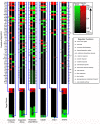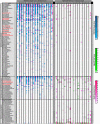A predictive model of the oxygen and heme regulatory network in yeast
- PMID: 19008939
- PMCID: PMC2573020
- DOI: 10.1371/journal.pcbi.1000224
A predictive model of the oxygen and heme regulatory network in yeast
Abstract
Deciphering gene regulatory mechanisms through the analysis of high-throughput expression data is a challenging computational problem. Previous computational studies have used large expression datasets in order to resolve fine patterns of coexpression, producing clusters or modules of potentially coregulated genes. These methods typically examine promoter sequence information, such as DNA motifs or transcription factor occupancy data, in a separate step after clustering. We needed an alternative and more integrative approach to study the oxygen regulatory network in Saccharomyces cerevisiae using a small dataset of perturbation experiments. Mechanisms of oxygen sensing and regulation underlie many physiological and pathological processes, and only a handful of oxygen regulators have been identified in previous studies. We used a new machine learning algorithm called MEDUSA to uncover detailed information about the oxygen regulatory network using genome-wide expression changes in response to perturbations in the levels of oxygen, heme, Hap1, and Co2+. MEDUSA integrates mRNA expression, promoter sequence, and ChIP-chip occupancy data to learn a model that accurately predicts the differential expression of target genes in held-out data. We used a novel margin-based score to extract significant condition-specific regulators and assemble a global map of the oxygen sensing and regulatory network. This network includes both known oxygen and heme regulators, such as Hap1, Mga2, Hap4, and Upc2, as well as many new candidate regulators. MEDUSA also identified many DNA motifs that are consistent with previous experimentally identified transcription factor binding sites. Because MEDUSA's regulatory program associates regulators to target genes through their promoter sequences, we directly tested the predicted regulators for OLE1, a gene specifically induced under hypoxia, by experimental analysis of the activity of its promoter. In each case, deletion of the candidate regulator resulted in the predicted effect on promoter activity, confirming that several novel regulators identified by MEDUSA are indeed involved in oxygen regulation. MEDUSA can reveal important information from a small dataset and generate testable hypotheses for further experimental analysis. Supplemental data are included.
Conflict of interest statement
The authors have declared that no competing interests exist.
Figures









Similar articles
-
Learning regulatory programs that accurately predict differential expression with MEDUSA.Ann N Y Acad Sci. 2007 Dec;1115:178-202. doi: 10.1196/annals.1407.020. Epub 2007 Oct 12. Ann N Y Acad Sci. 2007. PMID: 17934055
-
Improved recovery of cell-cycle gene expression in Saccharomyces cerevisiae from regulatory interactions in multiple omics data.BMC Genomics. 2020 Feb 13;21(1):159. doi: 10.1186/s12864-020-6554-8. BMC Genomics. 2020. PMID: 32054475 Free PMC article.
-
A classification-based framework for predicting and analyzing gene regulatory response.BMC Bioinformatics. 2006 Mar 20;7 Suppl 1(Suppl 1):S5. doi: 10.1186/1471-2105-7-S1-S5. BMC Bioinformatics. 2006. PMID: 16723008 Free PMC article.
-
Mapping yeast transcriptional networks.Genetics. 2013 Sep;195(1):9-36. doi: 10.1534/genetics.113.153262. Genetics. 2013. PMID: 24018767 Free PMC article. Review.
-
Identification of cis-regulatory elements in gene co-expression networks using A-GLAM.Methods Mol Biol. 2009;541:1-22. doi: 10.1007/978-1-59745-243-4_1. Methods Mol Biol. 2009. PMID: 19381547 Free PMC article. Review.
Cited by
-
Heme, A Metabolic Sensor, Directly Regulates the Activity of the KDM4 Histone Demethylase Family and Their Interactions with Partner Proteins.Cells. 2020 Mar 22;9(3):773. doi: 10.3390/cells9030773. Cells. 2020. PMID: 32235736 Free PMC article.
-
Hypoxia elicits broad and systematic changes in protein subcellular localization.Am J Physiol Cell Physiol. 2011 Oct;301(4):C913-28. doi: 10.1152/ajpcell.00481.2010. Epub 2011 Jul 13. Am J Physiol Cell Physiol. 2011. PMID: 21753182 Free PMC article.
-
Deletion of a subgroup of ribosome-related genes minimizes hypoxia-induced changes and confers hypoxia tolerance.Physiol Genomics. 2011 Jul 27;43(14):855-72. doi: 10.1152/physiolgenomics.00232.2010. Epub 2011 May 17. Physiol Genomics. 2011. PMID: 21586670 Free PMC article.
-
Inferring transcriptional and microRNA-mediated regulatory programs in glioblastoma.Mol Syst Biol. 2012;8:605. doi: 10.1038/msb.2012.37. Mol Syst Biol. 2012. PMID: 22929615 Free PMC article.
-
Genomic analysis of immune response against Vibrio cholerae hemolysin in Caenorhabditis elegans.PLoS One. 2012;7(5):e38200. doi: 10.1371/journal.pone.0038200. Epub 2012 May 31. PLoS One. 2012. PMID: 22675448 Free PMC article.
References
-
- Bunn HF, Poyton RO. Oxygen sensing and molecular adaptation to hypoxia. Physiol Rev. 1996;76:839–885. - PubMed
-
- Tai SL, Boer VM, Daran-Lapujade P, Walsh MC, de Winde JH, et al. Two-dimensional transcriptome analysis in chemostat cultures. Combinatorial effects of oxygen availability and macronutrient limitation in Saccharomyces cerevisiae. J Biol Chem. 2005;280:437–447. - PubMed
-
- Piper MD, Daran-Lapujade P, Bro C, Regenberg B, Knudsen S, et al. Reproducibility of oligonucleotide microarray transcriptome analyses. An interlaboratory comparison using chemostat cultures of Saccharomyces cerevisiae. J Biol Chem. 2002;277:37001–37008. - PubMed
Publication types
MeSH terms
Substances
Grants and funding
LinkOut - more resources
Full Text Sources
Other Literature Sources
Molecular Biology Databases
Research Materials
Miscellaneous

